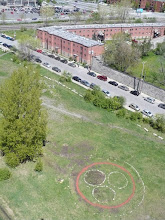
The Roerich Symbol brings together the idea of nature and culture.
I am using it in my garden piece as a temporary plant installation because it signifies protection. Used in WWII to prevent aerial bombing, this symbol is the cultural equivalent of the Red Cross and was installed on the rooftops of museums, churches, universities, historical and cultural monuments in WWII Europe. This field is slated for demolition as of 2009-2010 as the Arrondissement du Plateau-Mont-Royal has plans to extend rue St Viateur further East to connect to Henri-Julien. The plans also involve the expropriation and demolition of several resident homes along de Gaspé. The Roerich Garden was made to pay hommage to the field as well as to draw attention to its cultural importance.
I've always loved the writing of and been intrigued by Gary Snyder and recently learned that he was involved with the re-emergence of the deep ecology movement.
It emerged in the 60s and emphasized the valorization of wilderness. The founder of the movement, Norwegian, Arne Naess defined the movement to unite ideas, feelings, spirituality and action.
Was just informed of an eco-psychologist named Theodore Roszak. Eco Psychology in simple terms addresses the alienation between the person and the natural environment. He says:
"We need a new discipline that sees the needs of the planet and the person as a continuum and that can help us reconnect with the truth that lies in our communion with the rest of creation".
















